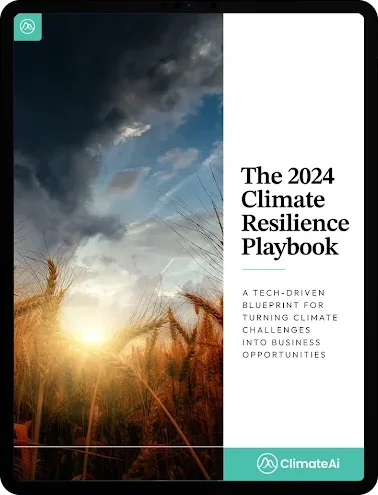
New Product Launch: ClimateLens Monitor Yield Outlook - see regional and location-specific yields on key commodity crops, updated weekly.Learn More

From planting through harvest, track outlooks for the crops you care about – in both key production regions and your specific sourcing locations
From droughts to heat waves to floods, we are seeing climate volatility wreak havoc on global supply chains. Get an edge on the market by using our climate and agronomy-driven yield forecasts to build more effective procurement strategies, drive contract negotiation with your suppliers, and take early action in commodity markets.
See your sourcing and procurement operations through ClimateLens, the industry’s most powerful climate resilience platform.

See all the crops you’re monitoring in a simple dashboard view – with at-a-glance yield outlook, benchmarked to historical data. Click into any card to get to a detailed dashboard.
See forecasted yields for key production regions, along with the key yield impact drivers. Data is refreshed weekly to give insight into how outlooks are shifting throughout the season based on climate variables.
Pinpoint your specific sourcing or growing or locations for localized yield outlooks. Our location-specific forecasts enable you to compare your locations’ forecasts & risks to broader regional and market conditions.
Fill out this quick form and we’ll tailor our session for you.
Covers a broader range of crops – each model is calibrated with unique risk parameters, by region
Provides forecasts from before planting all the way through harvest, with more frequent updates (weekly vs. monthly)
Leverages best-in-class, proprietary weather forecasts for the growing season
Offers insights at the country, state, and location-level – enabling users to compare outlooks for their specific sourcing / growing locations to broader market conditions
Case Study
ClimateAi Helps Advanta Climate-Proof its Business from End-to-End
See how ClimateAi helped this leading Australian seed company battle climate change-fueled weather variability.
Downloadable Content
Webinar: Harnessing Climate Intelligence for Natural Pest Management with MGK
MGK is leading the way in the production of a special insecticide active ingredient made from the pyrethrum daisy. In this webinar you'll get the opportunity to hear about MGK's climate resilience journey...

Climate resilience delivers a triple dividend for businesses: avoided losses, new market opportunities, and social and environmental benefits. Building a climate resilience strategy for your business can accelerate all three. In fact, climate resilience is one of the biggest market (and social) opportunities for companies today. ClimateAi has helped dozens of companies adapt to climate volatility, so we’ve got front-row seats to what works — and what doesn’t.
Check out our 2024 Climate Resilience Playbook for a detailed roadmap and case studies.

ClimateAi’s process-based crop model combines cutting edge agronomic science with machine learning techniques to estimate crop yields from meteorological data, soil characteristics, and agronomic actions. ClimateAi’s yield model has strong skill in estimating climate-related impacts on yield, given our best-in-class historical data, forecasting methodology, and crop-specific agronomic risk models, but does not account for other non-climate factors, such as pests.
Models are calibrated by crop and by region, translating weather-related hazards (e.g., extreme heat, drought) into impact on yield based on timing and severity of the hazard relative to the respective crop’s phenological stage and vulnerability to the hazard.
As a quality assurance practice, we require that our crop model be validated for each crop/region in terms of its ability to reproduce a reasonable fraction of the yield variability in historic yield records. ClimateAi will not offer yield outlooks for a crop/geography that hasn’t passed our threshold for a robust model.
For a model to be “validated robust” it needs to explain more than 20% of the observed yield variance through a leave-one-year-out (LOYO) cross-validation approach (1). This threshold is based on the fact that climate variability accounts for ~⅓ of yield variability(2), given other factors like agricultural practices, pests, and diseases.
1: LOYO cross-validation is a technique where each year in the modeled yield data is estimated by calibrating the model using all other years’ data, excluding the specific year being estimated. It helps assess how well a model generalizes to unseen data.
2: https://www.nature.com/articles/ncomms6989
From planting until the end of the harvesting stage, ClimateAi’s outlooks will refresh every Monday on a weekly basis. When a crop is “out of season” for a particular geography, dashboards will not update.
Monitor Yield Outlook offers clear forward-looking (vs. simply diagnostic) insights into climate impacts on production, drawing on our proprietary seasonal forecast data and deep knowledge of agronomic risk. Outlooks are updated on a weekly basis (vs. other reports’ seasonal or monthly cadence), providing up-to-date insights throughout the season. Alongside state and regional-level forecasts, we also deliver yield outlooks for customer’s specific growing / sourcing locations, enabling granular insight into supplier-specific sourcing risks. We also have the ability to complement seasonal outlooks with long-term yield projections, to help drive strategic planning and decision making.